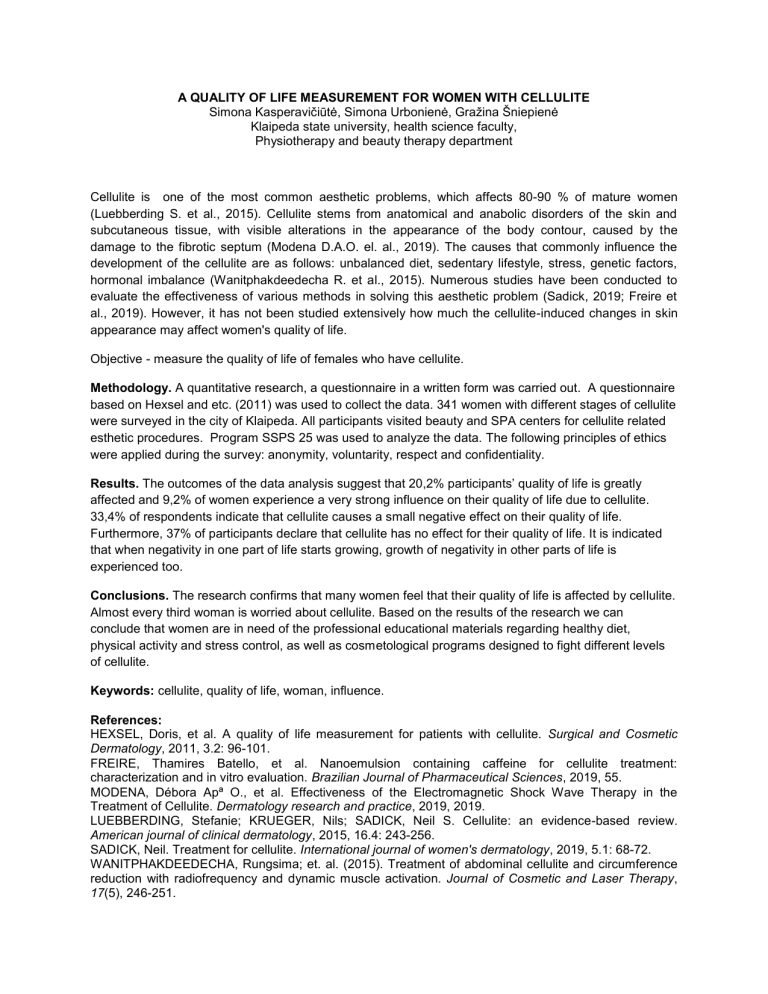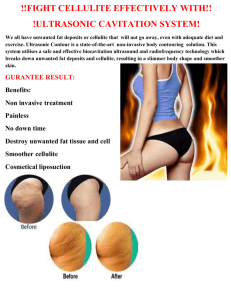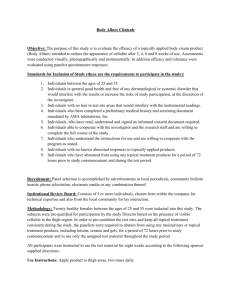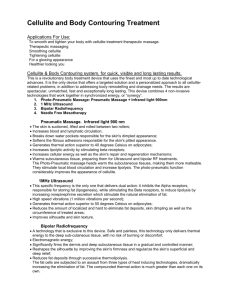
A QUALITY OF LIFE MEASUREMENT FOR WOMEN WITH CELLULITE Simona Kasperavičiūtė, Simona Urbonienė, Gražina Šniepienė Klaipeda state university, health science faculty, Physiotherapy and beauty therapy department Cellulite is one of the most common aesthetic problems, which affects 80-90 % of mature women (Luebberding S. et al., 2015). Cellulite stems from anatomical and anabolic disorders of the skin and subcutaneous tissue, with visible alterations in the appearance of the body contour, caused by the damage to the fibrotic septum (Modena D.A.O. el. al., 2019). The causes that commonly influence the development of the cellulite are as follows: unbalanced diet, sedentary lifestyle, stress, genetic factors, hormonal imbalance (Wanitphakdeedecha R. et al., 2015). Numerous studies have been conducted to evaluate the effectiveness of various methods in solving this aesthetic problem (Sadick, 2019; Freire et al., 2019). However, it has not been studied extensively how much the cellulite-induced changes in skin appearance may affect women's quality of life. Objective - measure the quality of life of females who have cellulite. Methodology. A quantitative research, a questionnaire in a written form was carried out. A questionnaire based on Hexsel and etc. (2011) was used to collect the data. 341 women with different stages of cellulite were surveyed in the city of Klaipeda. All participants visited beauty and SPA centers for cellulite related esthetic procedures. Program SSPS 25 was used to analyze the data. The following principles of ethics were applied during the survey: anonymity, voluntarity, respect and confidentiality. Results. The outcomes of the data analysis suggest that 20,2% participants’ quality of life is greatly affected and 9,2% of women experience a very strong influence on their quality of life due to cellulite. 33,4% of respondents indicate that cellulite causes a small negative effect on their quality of life. Furthermore, 37% of participants declare that cellulite has no effect for their quality of life. It is indicated that when negativity in one part of life starts growing, growth of negativity in other parts of life is experienced too. Conclusions. The research confirms that many women feel that their quality of life is affected by cellulite. Almost every third woman is worried about cellulite. Based on the results of the research we can conclude that women are in need of the professional educational materials regarding healthy diet, physical activity and stress control, as well as cosmetological programs designed to fight different levels of cellulite. Keywords: cellulite, quality of life, woman, influence. References: HEXSEL, Doris, et al. A quality of life measurement for patients with cellulite. Surgical and Cosmetic Dermatology, 2011, 3.2: 96-101. FREIRE, Thamires Batello, et al. Nanoemulsion containing caffeine for cellulite treatment: characterization and in vitro evaluation. Brazilian Journal of Pharmaceutical Sciences, 2019, 55. MODENA, Débora Apª O., et al. Effectiveness of the Electromagnetic Shock Wave Therapy in the Treatment of Cellulite. Dermatology research and practice, 2019, 2019. LUEBBERDING, Stefanie; KRUEGER, Nils; SADICK, Neil S. Cellulite: an evidence-based review. American journal of clinical dermatology, 2015, 16.4: 243-256. SADICK, Neil. Treatment for cellulite. International journal of women's dermatology, 2019, 5.1: 68-72. WANITPHAKDEEDECHA, Rungsima; et. al. (2015). Treatment of abdominal cellulite and circumference reduction with radiofrequency and dynamic muscle activation. Journal of Cosmetic and Laser Therapy, 17(5), 246-251.




